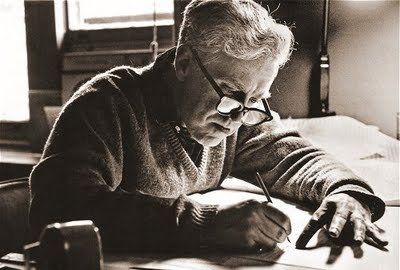Cantus Firmus Meets Jazz: Craft Your Own Elliott Carter-Inspired Orchestral Passage
If you’re like me, sitting down to listen to a 30-minute symphony is a rarity these days. Whenever a piece captures my attention from start to finish, it’s a powerful sign in the music’s favor.
Discovering Elliott Carter’s First Symphony
Elliott Carter, composing
That happened to me just this week with Elliott Carter’s First Symphony. The opening Bbm7add-13 string chord hooked my attention. The subsequent jazzy chord in bar 13 reeled me in. Then, the woodwind counterpoint against the pizzicato chords created a mysterious contrast. I had to know why such different sounds so close together belonged in the same piece.
30 minutes later I had listened to the whole thing in one sitting. Let me share what you can learn from the symphony you can apply to your own music that will hook listeners and give them goosebumps. . . .
These days, Elliott Carter is best known for his avant-garde music from the 60s and 70s. Before he got there, though, he was a student of Nadia Boulanger. His First Symphony is in the same sort of neoclassical, American style like his fellow Boulanger pupils Aaron Copeland and Roy Harris wrote.
Analyzing the Symphony’s Style
In many ways, Carter’s First Symphony is like a brainy version of Aaron Copland. Brainy—in the sense that it is filled with rich counterpoint, not in the sense that it is emotionally reserved. In fact, it’s richly expressive, both emotionally and musically.
Every phrase has some lovely detail and is carefully considered. It marries Beethoven-ian motivic development with an extended tonal harmonic vocabulary, masterful orchestration, and counterpoint that screams, “I am a product of the French conservatory tradition.”
A Standout Passage from the Second Movement
One of my favorite passages is the second movement’s trumpet solo.
One of my favorite passages comes in the second movement. Around bar 618, Carter writes a solo trumpet melody against a viola cantus firmus and embellished with imitative, triplet figures in the rest of the orchestra. The effect is earnest and gentle, like a grandparent telling you a compelling story from their childhood.
(For those who haven’t heard the term, cantus firmus is an old (~800 years) technique where composers use a melody in long notes (the cantus firmus, i.e., “fixed melody”) as the backbone for new counterpoint. It makes composing easier because it decides the form of a passage even before you add the rest of the texture.)
The clarity of this passage in Carter’s Symphony would make it a great one to study and imitate.
How to Imitate Carter's Technique: A Step-by-Step Guide
Here’s how I would do it:
Write a half-note cantus of 8-16 bars. Don’t think too hard about it. As long as the melody has a clear sense of direction, almost any sequence of mostly stepwise notes will do. (Avoid leaping around.)
Orchestrate that melody for divisi violas, half arco/half pizz. at the unison
Write a countermelody to the cantus, mostly in quarter notes. Carter used the solo trumpet, but any contrast of timbre and register will work well. (You can also leap around more with this melody.)
To finish it off, add fanfares of eighth-note triplets, passed around the instruments of the orchestra.
Overall, this prompt would take somewhere between 30-90 minutes to write.
Conclusion: Your Turn to Compose
I’d love to see what you come up with!
Email joseph@composersschool.com with a PDF and mp3, and the best compositions will win a free 20-minute lesson with me.



